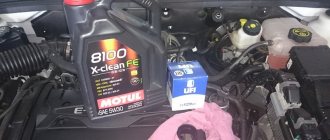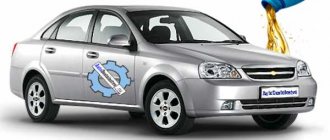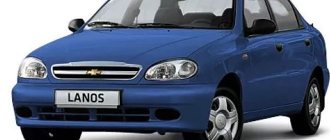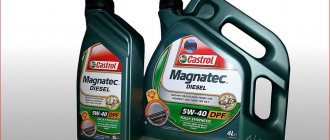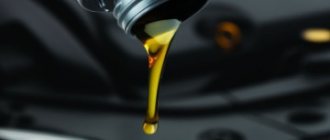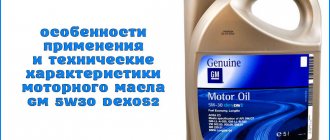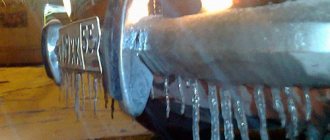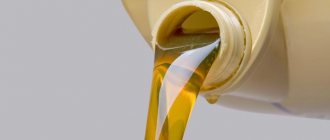Stages of replacing lubricant Chevrolet Lanos
Replacing the engine fluid is possible without removing the engine protection, since it has a drain hole. And the oil filter can be reached from the engine compartment; it is located quite conveniently.
This model was produced in different countries under different car brands, as well as with different model names and minor design differences. Therefore, the replacement instructions will be applicable for the following varieties:
- Chevrolet Lanos;
- Daewoo Sens;
- FSO Lanos (FSO Lanos);
- ZAZ Lanos;
- ZAZ Sens;
- ZAZ Chance;
- Doninvest Assol.
Daewoo Lanos;
How to change the oil in a Chevrolet Lanos engine with your own hands?
The car must always be in working order. The main component for maintaining excellent performance is the power unit. Its service life directly depends on the quality of the oil and oil filter. But over time, the liquid loses its beneficial properties. Therefore, for proper engine operation, it is necessary to replace the engine oil in the power unit.
Replacement frequency, what oil to fill
According to the manufacturer's regulations, service changes of engine oil on Chevrolet Lanos are carried out after 15,000 kilometers or at intervals of 1 year. But some car owners consider this interval to be a little too high, recommending that it be shortened taking into account operating conditions.
According to the passport and the operating instructions, the tolerances that the engine oil must have are given. The manufacturer's recommendation indicates the use of original oil, in this case it is GM Motor Oil 5W-30 Dexos2.
The manufacturer allows the use of analogues, the only thing is that they must be Dexos2 approved. The following oils are most popular among car owners:
- Castrol EDGE 5W-30
- Elf Solaris LLX SAE 5W-30
- Liqui Moly Top Tec 4200 5W-30
- Mobil 1 ESP 5W-30
- Shell Shell Helix Ultra ECT C3 5W-30
- Total Quartz Ineo MC3 5W-30
- Valvoline SynPower MST C3 5W-30
- Wolf Official Tech 5W-30
- ZIC X9 LS 5W-30
- Lukoil Genesis Claritech 5W-30
How much oil is in the engine lubrication system, volume table
| Model | Engine capacity | Motor marking | How many liters of oil are in the system | Original oil / factory filled |
| Chevrolet Lanos | gasoline 1.5 | A15SMS | 3.75 | GM Motor Oil 5W-30 Dexos2 / Or any with Dexos2 approval |
The best oils for Lanos and their benefits
Experienced motorists recommend using branded synthetic lubricant GM 5W-30 Super Synthetic. We can also recommend products from other manufacturers: Castrol EDGE SAE 0W-30, Castrol Magnetic 5W-30, Elf Evolution SXR 0W-30, and Elf Excellium GM 5W-30. Let's look at each of these oils in detail.
- GM 5W-30 Super Synthetic is an original lubricant from the American concern General Motors. Car enthusiasts respond positively to this product and recommend it as a first refill. This oil is used not only for Chevrolet Lanos, but also for the most modern engines produced by the GM concern. The fluid is designed for a long service life and has a long replacement schedule. It has low viscosity and is therefore perfectly optimized for high temperatures. The excellent characteristics of Super Synthetic guarantee reliable engine operation regardless of its load and service life.
- Castrol EDGE SAE 0W-30 is another synthetic oil with an impressive drain interval of 50 thousand kilometers. Perhaps this is the only lubricant for Lanos with such regulations. This oil can reduce fuel consumption and protect the engine from wear of its expensive components. Castrol EDGE SAE 0W-30 is recommended to be used only in its pure form, without any additives.
- Elf Excellium GM 5W-30 is a synthetic oil that will be an excellent option for both well-preserved Chevrolet Lanos engines and engines with high mileage. The oil is designed for the most severe operating conditions, and due to this it can be recommended to Russian motorists. Elf Excelium GM 5W-30 significantly saves fuel, reduces toxicity and improves environmental friendliness, and even allows you to maximize the dynamic capabilities of the power plant.
- Elf Evolution SXR 0W-30 is a new generation motor oil. It has an extended replacement interval and is significantly superior to its competitors in its characteristics. A Chevrolet Lanos car with this oil can be used in extreme conditions - both in the city and outside the city. Elf Evolution also has a positive effect on fuel economy and increased engine power characteristics. The oil has good antioxidant abilities, and at the same time a low ash level.
- Castrol Magnetic 5W-30 - this oil provides effective engine protection against premature wear and will extend the life of the entire vehicle. With such a lubricant, dry friction will never occur between motor components. Castrol oil meets all the parameters specified in the instructions for the Chevrolet Lanos.
Leaks and problems
The longer the Chevrolet Lanos mileage increases, the more problems appear, as in principle in any car. Most often this is due to natural wear and tear of the engine, causing oil to burn. Although the manufacturer allows for a small consumption.
Owners call oil leakage from under the ignition coil one of the common problems on Lanos. The problem is actually trivial and can be treated in 10 minutes. You need to remove the cover and replace the rubber o-ring, here is the original part number GM 96351738. It costs a penny, but for some reason many people prefer to put the old one on the sealant.
Also, leaks are often observed from under the cylinder head gasket, simple wear of which is possible, but unlikely. Most likely the engine was overheated and a slight bend in the cylinder head appeared. Only sanding will help here.
But in case of a big burn, you should pay attention to the oil scraper rings, most likely they are stuck. In this case, if decarbonization helps, it will not be for long, especially since there is a possibility of clogging the thin oil channels. The most effective way is capital with replacement of rings.
All this is general information, which may manifest itself differently on each specific vehicle, since everyone’s operating modes are different. The same applies to leak locations; it is impossible to identify the cause from a distance.
Types of motor oils
At the end of the article, let us pay attention to the three main types of motor oils.
- Synthetic is the best lubricant with a wide range of advantages. Firstly, this is the most fluid oil, not afraid of low temperatures. Secondly, synthetics are designed to last a long time. Thirdly, this oil has excellent non-stick and anti-corrosion properties, and is recommended for all modern cars.
- Mineral oil is the exact opposite of synthetic oil. It can be recommended for old cars with high mileage. It has one advantage - it is cheap. Disadvantages - low resistance to low temperatures, tendency to harden, short service life, large amount of harmful substances.
- Semi-synthetic oil is not much better than mineral lubricant, but at the same time, it is considered a worthy alternative. It can be used for modern foreign cars with high mileage, as well as at moderately low temperatures. An ideal option for those who do not want to purchase expensive synthetic oil.
We can conclude that for Chevrolet Lanos the best choice would be synthetic or semi-synthetic oil.
Recommendations for changing the engine oil of a Lanos car
Chevrolet Lanos cars are found everywhere in Russia and abroad. The machine is characterized by good technical capabilities, accessibility and budget maintenance. The oil change procedure in Lanos is considered one of the most common. Some people visit a car service center for this, although in practice you can replace the lubricant in the engine with your own hands.
When to change and how much oil to pour into the Lanos Chevrolet 1.5 engine
The engine oil must be changed in accordance with the requirements of the vehicle's routine maintenance, at least every 10,000 km.
.
In addition to the engine mileage, lubricant replacement is affected by the duration of its use in the engine. This is due to the fact that the properties of the oil deteriorate not only during engine operation, but due to the natural aging process of the oil. Also, changing the oil is influenced by the conditions under which the machine is operated. If starting a cold engine occurs quite often or the car is driven with frequent downtime, for example, due to city traffic jams, then the frequency of engine lubrication changes is significantly reduced to 5000 km
.
The replacement interval should also be adjusted according to other severe operating conditions. These include:
- predominant trips are short distances up to 7 km;
- frequent trips in the cold season at a distance of up to 17 km;
- car operation in dusty areas.
To change the oil in a Chevrolet Lanos engine, you will need 3.75 L of engine oil, including a filter.
Price for engine oil change in Lanos
You can change the oil in the Lanos engine either yourself or by contacting specialists. On average in Russia, the price for an oil change (this service also includes filter replacement) for an engine in a given car is 500 rubles, excluding the cost of oil and filter. Overall, with consumables it will cost 1500-2000 thousand.
Replacement frequency
Some car owners adhere to the principle that the engine oil needs to be changed when the warning lights on the dashboard come on or the engine begins to behave inappropriately. This is the wrong approach. The engine oil in Chevrolet Lanos cars should be changed as its physical and chemical properties are lost. Try to drain the old fluid before active friction of the internal parts and their wear begin. This will prevent serious damage and costly repairs to the entire power unit.
The time interval between replacements depends on:
- age of the car and engine;
- driving style;
- oil used;
- quality of gasoline being poured;
- frequency of vehicle operation.
Some people believe that if the car is rarely used, the engine is preserved better and the oil and other consumables need to be changed less often. But that's not true. Prolonged downtime leads to the formation of condensation, which mixes with the lubricant and disrupts its composition. Such a mixture is not capable of performing its functions, and therefore needs to be replaced.
According to the regulations, on Chevrolet Lanos cars the lubricant in the engine should be changed every 12 months or every 10 thousand kilometers. But when a car owner uses frankly cheap compounds and operates the car in extreme conditions, the frequency is reduced to 7–8 thousand kilometers. If mineral oil is used, replacement should be carried out every 6 thousand kilometers.
Chevrolet Lanos 1.5 A14SMS and A15SMS engines
The A14SMS and A15SMS engines are almost the same, but there are design differences: the piston stroke in the A14SMS is 73.4 mm; in A15SMS – 81.5 mm. This entailed an increase in cylinder volume from 1.4 to 1.5 liters. The diameter of the cylinders did not change - 76.5 mm.
Both engines are 4-cylinder in-line engines equipped with a SOHC gas distribution mechanism. Each cylinder has 2 valves (one for intake, the other for exhaust). The engines run on AI-92 gasoline and comply with Euro-3 environmental standards. There are differences in power and torque:
A14SMS – 75 hp, 115 Nm A15SMS – 86 hp, 130 Nm Among these internal combustion engines, the A15SMS model turned out to be the most popular due to its improved performance characteristics. It is a development of the G15MF internal combustion engine, previously installed on the Daewoo Nexia. The engine received some features: plastic valve covers, electronic ignition module, control system sensors. Catalytic exhaust gas converters and oxygen concentration sensors are used here, which has significantly reduced the amount of harmful substances in the exhaust. Plus, a knock sensor and camshaft position sensor were installed on the engine.
Obviously, this engine was tuned for low fuel consumption, so you shouldn’t expect exceptional performance from it. The timing drive is a belt drive; the belt itself and the tension roller require replacement every 60 thousand kilometers. Otherwise, the belt may break, followed by bending of the valves. This will lead to a major overhaul. The system uses hydraulic compensators, so adjustment of valve clearances is not required. Like the previous engine, the A15SMS internal combustion engine runs 250 thousand kilometers with timely maintenance. On forums, owners write about a mileage of 300 thousand without major repairs, but this is rather an exception. As for maintenance, the A15SMS needs to change the oil after 10 thousand km, preferably after 5000 km due to the low quality of lubricants on the market and the spread of counterfeits. The manufacturer recommends using oil with a viscosity of 5W30 or 5W40. After 20 thousand kilometers, the crankcase and other ventilation holes need to be purged and spark plugs replaced; After 30 thousand, it is advisable to check the condition of the hydraulic compensators; after 40 thousand, replace the coolant and fuel filter. A15DMS is a modification of the A15SMS motor. It uses 2 camshafts and 16 valves - 4 for each cylinder. The power plant is capable of developing 107 hp, according to other information – 100 hp. The next difference from the A15SMS is that the attachments are different, but most of the parts are interchangeable.
This modification has no tangible technical or design advantages.
It absorbed the disadvantages and advantages of the A15SMS motor: reliability, simplicity. There are no complex components in this motor; repairs are easy. In addition, the unit is lightweight - there were cases when it was pulled out from under the hood by hand, without the use of special cranes. Problems
The disadvantages are typical: bending of valves when the timing belt breaks, a problematic EGR valve, which gets dirty and “glitches” due to bad gasoline. However, it’s easy to turn it off, flash the ECU and forget about the Check Engine light. Also, on all three engines, the idle speed sensor operates under high loads, which is why it often breaks. It is easy to determine the breakdown - the idle speed is always high. Replace it and be done with it. “Stuck” oil scraper rings are a classic problem with high-mileage internal combustion engines. It also occurs here. The solution is trivial - decarbonizing the rings or, if that doesn’t help, replacing them. In Russia and Ukraine, due to the low quality of gasoline, the fuel system becomes clogged, causing the injectors to produce uneven injection of the mixture into the cylinders. As a result, detonation, speed surges and other “symptoms” occur. The solution is to replace or clean the injectors. The engine, gearbox and clutch form the power unit - a single unit mounted in the engine compartment on three elastic rubber-metal supports. The right support is attached to a bracket located on the front wall of the cylinder block, and the left and rear ones are attached to the gearbox housing.
Composition selection
When choosing engine oil for Chevrolet Lanos, you should pay special attention to viscosity tolerances and classes. These are the main characteristics with the help of which the optimal composition of the lubricating fluid is selected. If we use the American API classification, the following types of oils are suitable for this car:
Don't forget about viscosity grades. The following options are suitable for Lanos:
It is not recommended to use low-quality and viscous compounds, as this will lead to a gradual deterioration of the condition of the power unit and wear of its components.
Among the recommended oils for the Chevrolet Lanos engine are the following manufacturers:
In addition to the oil itself, to replace the lubricant you will need to simultaneously change the old oil filter. It plays a vital role, so use only high-quality options to separate the oil in the engine. Filters from Mann and Hexen are optimal for Lanos.
Synthetic vs semi-synthetic
The list of recommended motor oils for Chevrolet Lanos cars includes all three types of formulations:
- mineral;
- synthetic;
- semi-synthetic.
But mineral oils do not have sufficient physical and chemical properties to ensure proper engine operation under all conditions and under severe loads. Therefore, car owners mainly choose between synthetic and semi-synthetic compounds. They have the following advantages over mineral motor oils:
- retain physical and chemical properties for a long time;
- withstands overheating and sudden temperature changes;
- considered energy saving;
- more effectively protect the engine from wear;
- have higher low-temperature viscosity;
- provide long service life.
Semi-synthetics are considered an intermediate option between mineral and synthetic compounds. When in winter the air temperature does not drop below -25 degrees Celsius, the only argument in favor of synthetics will be low-temperature viscosity. But under such conditions, it is not advisable to spend more money on synthetic oil. Also, experts do not recommend using synthetics on a Lanos if it has an impressive mileage, is very actively used and often loses oil due to leaks caused by its technical condition.
When choosing a lubricant for your power unit, buy with a reserve. When changing oil in a Chevrolet Lanos engine, you will need to use about 4 liters. A spare volume of oil will be needed during periodic checking of the level and topping up the mixture as it is consumed.
Classification of oils
High-quality motor oils are characterized by various parameters, and each engine of a particular car has its own parameters. The same applies to the Chevrolet Lanos engine line.
Among the most important parameters is the degree of viscosity, which is indicated in the form of large letters SAE. The degree of viscosity determines how well the power plant is adapted to specific environmental temperature conditions. If you do not pay attention to the numbers, motor oil can be divided into three classes based on viscosity - summer, winter and all-season.
Let's consider all classes of motor oils and their parameters that are suitable for the Chevrolet Lanos engine line:
- API SJ
- ACEA A1/A2/A3
- SAE 5W-40
- SAE 10W-40
- SAE 15W-40
- Opel GM-LL-A-025
Materials and tools
To drain the old oil and pour new lubricant into the engine, you will need to collect the necessary list of materials and tools. If you are going to do the work yourself, then prepare:
- new engine oil;
- new filter;
- new sealing gasket;
- new oil pan;
- spanners sizes 17 and 19;
- key for dismantling the filter;
- Screwdriver Set;
- empty container for draining old oil;
- rags;
- funnel for pouring lubricant into the motor.
As for the new oil pan, experienced specialists recommend changing it after every second oil change. This is due to the fact that over time, the process of fogging begins near the pallet box and condensation forms. At first this is not a cause for concern. But as the car is used, engine performance deteriorates. You may encounter various breakdowns in the future. Experienced Chevrolet Lanos car owners advise taking a copper pan. It's better, but more expensive. If you don’t want to spend money on a copper pallet, take a cheaper aluminum one.
Popular oils for Lanos cars
If you have not yet decided which oil to pour into Lanos, you can choose one of the above. All of them are perfect for use on Chevrolet and Deo Lanos cars.
Experts recommend changing the engine fluid every 8-15 thousand kilometers. We can say that for normal operation of the car it will be enough to replace the lubricant once a year. But some Chevrolet Lanos owners do not agree with this opinion. They believe that it is worth changing the oil every 5-7 thousand kilometers.
In fact, the frequency of lubricant changes largely depends on the specific operating conditions of the machine, driving style and many other factors. But if the transmission fluid needs to be replaced too often, this may indicate its overuse. In this case, you can try choosing a different class of oil or a different manufacturer. You shouldn't skimp on buying lubricant. After all, the service life of the car engine depends on it.
In order to choose the right type of motor oil for your engine, you need to carefully examine and weigh everything. Although the Chevrolet Lanos is not anything special, it is necessary to pay special attention to its needs.
Replacement procedure
To change the oil in a Chevrolet Lanos engine, it is recommended to work in a garage with a pit. As a last resort, use a jack. Although with a pit it is more reliable and safer. Lifts are unlikely to be found in the garages of ordinary car owners. Please read the safety instructions first as you will be working with hot oil. To avoid getting burned, be careful and be sure to use personal protective equipment (closed thick clothing, shoes, glasses, gloves, etc.).
When everything is ready, you can begin to drain the oil from the Chevrolet Lanos and pour fresh lubricant into the engine. We'll tell you step by step how this is done.
- If the car has been parked in the garage for a long time, the engine will need to be warmed up to about 90 degrees. This will make the oil less viscous and will flow out of the crankcase faster.
- The car is placed on the pit, the wheels are fixed, the parking brake is applied, and for safety reasons the negative terminal from the battery is disconnected. This will de-energize your Chevrolet Lanos.
- Place the key on the drain plug from below.
Begin to unscrew it carefully, without sudden movements, so as not to break the thread. You can drain the oil using the drain hole by placing an empty container of sufficient volume under it.
Additionally, you can open the filler plug, which will somewhat speed up the release of lubricant from the engine.
- While the oil is draining, move on to the oil filter. On Lanos it is located in the front part of the block, near the exhaust manifold. On 8-valve engines, getting to the filter is more difficult, so you have to work a little. Having a special key for removing the filter will simplify the task.
- If there is no oil filter puller, try using a clean rag, grab the filter housing with it and turn it. Usually most people manage to remove it.
- After removing the filter, pour some oil into it. It is recommended to first clean the filter seats and the area around the drain and fill plugs. This will make it easier to remove them later.
- Now you can install the new filter and tighten it tightly. Without fanaticism, because with excessive force you will simply damage the housing of the filter device and you will have to buy a new one.
- Be sure to change the sealing gasket, since the old one has worn out and is no longer suitable for further use. Gaskets are changed with every oil change in the power unit on a Chevrolet Lanos.
- Unscrew the valve cover in the engine compartment, insert a funnel and begin to gradually pour in fresh lubricant. When the required volume is filled, close the lid, insert the dipstick and start the Lanos engine.
- The engine should run for 30 - 40 minutes. This will allow the oil to fill the internal space and distribute throughout the system. The oil level usually drops after this, so you will need to add the missing amount and check the condition with the dipstick again.
Daewoo Lanos
- Engine
- Ignition system
- Clutch and gearbox
- Brake system
- Tires and wheels
- Steering
- Suspension
- Fuel system
- Lubrication system
- Cooling system
- Power supply system
- Dimensions and weight
Engine Daewoo-Lanos (L-4 with overhead camshaft)
| Name | 1.3L SOHC, manual | 1.5L DOHC, manual (automatic) | 1.6L DOHC, manual (automatic) |
| Maximum speed (km/h) | 166 | 172(161) | 180(173) |
| Minimum turning radius (m) | 4,9 | 4,9 | 4,9 |
| Cylinder diameter (mm) | 76,5 | 76,5 | 79 |
| Piston stroke (mm) | 73,4 | 81,5 | 81,5 |
| Total engine volume (cm3 | 1349 | 1498 | 1598 |
| Compression ratio | 9,5:1 | 9,5:1 | 9,5:1 |
| Maximum power kW(hp) | 55(74) at 5400 rpm | 63(84) at 5800 rpm | 77.8(104) at 6000 rpm |
| Maximum torque (Nm) | 115 at 3400 rpm | 130 at 3400 rpm | 145.3 at 3400 rpm |
Ignition system DEU-Lanos
| Name | 1.3L SOHC, manual | 1.5L DOHC, manual (automatic) | 1.6L DOHC, manual (automatic) |
| Type | Direct acting ignition distributor | Direct acting ignition distributor | Direct acting ignition distributor |
| Ignition timing (°) | 10 (BTDC) | 10 (BTDC) | 10 (BTDC) |
| Ignition sequence | 1-3-4-2 | 1-3-4-2 | 1-3-4-2 |
| Gap between spark plug electrodes (mm) | 0,7-0,8 | 0,7-0,8 | 1,0-1,1 |
| Spark plugs (manufacturer) | Champion/Woojin | Champion/Woojin | Woojin |
| Spark plug type | RN9YC/BPR6ES | RN9YC/BPR6ES | BKR6E-11 |
Clutch and gearbox Daewoo Lanos
| Name | 1.3L SOHC, manual | 1.5L DOHC, manual (automatic) | 1.6L DOHC, manual (automatic) |
| Clutch type | Dry single disc | Dry single disc | Dry single disc |
| Clutch Outer Diameter(mm) | 184 | 200 | 215 |
| Inner diameter (mm) | 127 | 134 | 145 |
| Thickness (mm) | 7,65 | 7,65 | 7,65 |
| Liquid | Brake fluid | Brake fluid | Brake fluid |
| Gearbox Manufacturer | DWMC | DWMC(General Motors) | DWMC(General Motors) |
| Transmission type or model | D-16 | D-16(4T40E) | D-16(4T40E) |
| Gear ratio: 1st gear 2nd gear 3rd gear 4th gear 5th gear Reverse | 3,545:1 1,952:1 1,276:1 0,892:1 0,707:1 3,333:1 | 3,545:1(2,957:1) 2,048:1(1,623:1) 1,346:1(1,000:1) 0,971:1(0,682:1) 0,763:1 3,333:1(2,143:1) | 3,545:1(2,957:1) 2,158:1(1,623:1) 1,478:1(1,000:1) 1,129:1(0,682:1) 0,886:1 3,333:1(2,143:1) |
| main gear | 3,944:1 | 4,176:1(3,91:1) | 3,722:1(3,91:1) |
| Oil fill volume (l) | 1,8 | 1,8(11,5) | 1,8(11,5) |
Brake system DEU-Lanos
| Name | 1.3L SOHC, manual | 1.5L DOHC, manual (automatic) | 1.6L DOHC, manual (automatic) |
| Brake booster size (mm) | 228,6 | 228,6 | 228,6 |
| Brake master cylinder diameter (mm) | 20,64 | 20,64 | 20,64 |
| Gain | 5,0:1 | 5,0:1 | 5,0:1 |
| Front brakes | Ventilated, disc | Ventilated, disc | Ventilated, disc |
| Rear drum brakes, drum inner diameter (mm) | 200 | 200 | 200 |
| Volume of brake fluid to be filled (l) | 0,5 | 0,5 | 0,5 |
Tires and wheels Daewoo Lanos
| Name | 1.3L SOHC, manual | 1.5L DOHC, manual (automatic) | 1.6L DOHC, manual (automatic) |
| Tire type | 155/80R13; 175/70R13 | 175/70R13 | 185/60R14 |
| Standard wheel size | 5JX13(steel) | 5JX13(steel) | 5.5JX14(steel) |
| Optimal wheel size | 5.5JX14(aluminum) | ||
| Full Load Pressure for 155/80R13 (psi) | 35 | ||
| Full Load Pressure for 175/70R13 (psi) | 32 | 32 | |
| Full Load Pressure for 185/60R14 (psi) | 32 |
Steering of Daewoo-Lanos
| Name | 1.3L SOHC, manual | 1.5L DOHC, manual (automatic) | 1.6L DOHC, manual (automatic) |
| Mechanism type | Power Rack & Pinion Steering | Power Rack & Pinion Steering | Power Rack & Pinion Steering |
| Overall gear ratio (manual) | 24,5:1 | ||
| Overall gear ratio (with booster) | 16,12:1 | 16,12:1 | 16,12:1 |
| Steering wheel diameter (mm) | 380 | 380 | 380 |
| Front wheel alignment | 10'±10'(-1±1mm) | 10'±10'(-1±1mm) | 10'±10'(-1±1mm) |
| Front wheel caster angle (manual control) | 30′-2°30′ | ||
| Front caster angle (power-assisted) | 1°45′-3°45′ | 1°45′-3°45′ | 1°45′-3°45′ |
| Front camber angle | -1°10’±20′ | -1°10’±20′ | -1°10’±20′ |
| Rear wheel alignment | -10'±40'(-1±4mm) | -10'±40'(-1±4mm) | -10'±40'(-1±4mm) |
| Rear wheel camber angle | -2°10′..-1°10′ | -2°10′..-1°10′ | -2°10′..-1°10′ |
| Oil volume (l) | 1,0 | 1,0 | 1,0 |
Daewoo-Lanos suspension
| Name | 1.3L SOHC, manual | 1.5L DOHC, manual (automatic) | 1.6L DOHC, manual (automatic) |
| Front suspension | McPherson | McPherson | McPherson |
| Rear suspension | Compound connection | Compound connection | Compound connection |
Fuel system Daewoo-Lanos
- Fuel Delivery - MPI
- Fuel pump type - electric pump;
- Fuel filter type - cartridge;
- Fuel tank volume - 48 l.
Lubrication system DEU-Lanos
- System type - with forced feed;
- Oil pump type - with a two-centric rotor;
- Oil filter type - cartridge (full flow);
- The capacity of the lubrication system, including the oil filter, is 3.75 liters.
Cooling system DEU-Lanos
- Cooling type - with forced circulation of liquid;
- Radiator type: cross-flow;
- Water pump type - centrifugal;
- Thermostat type - ball;
- Coolant volume - 7.0 l.
Power supply system Daewoo-Lanos
- Battery - 550A at cold start;
- Alternator - 85 A;
- Starter (DC no load) 0.8 kW - maximum - 53 A (at 11.5 V);
- Starter (DC no load) 1.4 kW - minimum - 40 A; maximum - 90 A (at 12.2 V).
Dimensions and weight of DEU-Lanos
- Full length (3/4/5-door), m - 4,074/4,237/4,074;
- Front overhang, m - 0.838;
- Rear overhang (3/4/5-door), m - 0.716/0.879/0.716;
- Full width, m - 1.678;
- Total height, m - 1.432;
- Ground clearance, mm - 160;
- Center base, m - 2.520;
- Front wheel track, m - 1.405;
- Rear wheel track, m - 1.425;
- Curb weight of a car with a manual transmission (3/4/5-door), kg: 1.3L SOHC engine - 1005/1030/1015
- Engine 1.5L DOHC - 1011/1036/1021
- Engine 1.6L DOHC - 1031/1056/1041
- Engine 1.5L DOHC - 1047/1072/1057
- Engine 1.3l SOHC - 1595/1595/1595
- Engine 1.5L DOHC - 1595/1595/1595
Top of page
